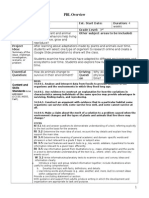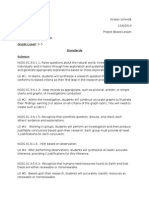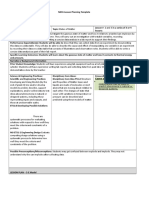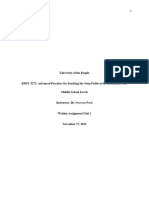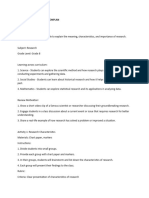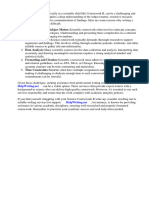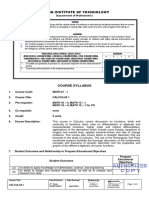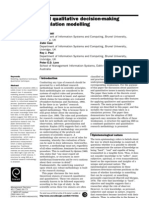Cluster 2: Materials and Structures: Grade 3
Cluster 2: Materials and Structures: Grade 3
Uploaded by
api-172952819Copyright:
Available Formats
Cluster 2: Materials and Structures: Grade 3
Cluster 2: Materials and Structures: Grade 3
Uploaded by
api-172952819Original Title
Copyright
Available Formats
Share this document
Did you find this document useful?
Is this content inappropriate?
Copyright:
Available Formats
Cluster 2: Materials and Structures: Grade 3
Cluster 2: Materials and Structures: Grade 3
Uploaded by
api-172952819Copyright:
Available Formats
Grade 3
Cluster 2: Materials and Structures
Overview
Students learn about the nature of materials not just by
observing them but, more importantly, by using them. In this
cluster, students experience the design process as they
manipulate and test materials, build structures, and select and
use materials suitable to the task at hand. Students find that
the strength and stability of structures in their community, as
well as those they build themselves, are linked to the properties
of the materials used and to the particular way the materials
are configured and joined. This cluster further develops the
concept of materials introduced in Kindergarten, Cluster 3:
Paper and built upon in Grade 1, Cluster 3: Characteristics of
Objects and Materials.
Kindergarten to Grade 4 Science: A Foundation for Implementation
PRESCRIBED LEARNING OUTCOMES
SUGGESTIONS FOR INSTRUCTION
Students will...
3-2-01 Use appropriate vocabulary
related to their investigations of
materials and structures.
Introduce, explain, use, and reinforce the vocabulary throughout
the cluster.
Include: strength, balance, stability,
structure, frame structure, natural
structure, human-built structure, force.
GLO: C6, D3
3-2-02 Conduct experiments to
compare the strength of common
materials.
Examples: wooden toothpicks, plastic
straws, paper, cardboard, polystyrene
foam...
GLO: A1, A2, C2, D3
3-2-03 Explore to determine ways to
strengthen a material used for
building.
Include: changing shape, bulk, and
number of layers.
GLO: B1, C2, D3
3-0-1b. Make predictions based on observed
patterns, collected data, or data provided from
other sources. (ELA 1.1.1; Math SP-IV.2.3) GLO:
A1, C2
3-0-3a. Brainstorm, with the class, one or more
methods of finding the answer to a given
question and reach consensus on which method
to implement. GLO: C2, C7
3-0-3b. Identify, with the class, variables that
have an impact on an investigation. GLO: A1,
A2, C2, C7
3-0-3c. Create, with the class, a plan to answer
a given question. (ELA 3.1.4) GLO: C2, C7
3-0-4a. Carry out a plan, and describe the steps
followed. (Math SP-V.2.3) GLO: C2
3-0-5a. Make observations that are relevant to a
specific question. GLO: A1, A2, C2
3-0-6c. Place materials and objects in a
sequence or in groups using two or more
attributes, and describe the system used. (Math
PR-I.1.3) GLO: C2, C3, C5
3-0-7a. Draw a simple conclusion based on their
observations. GLO: A1, A2, C2
(continued)
3. 18
Gaining Student Interest
Ask students the following questions:
Why are certain materials selected or rejected for building
structures?
How can the strength of some materials be increased?
Sorting Objects by Strength
Provide a variety of materials for students to sort according to
strength. Include toothpicks, spaghetti, popsicle sticks, straws,
and an assortment of paper and polystyrene foam. Have students
predict material strength by listing materials in order of strength
from weakest to strongest.
Investigating Materials for Strength
Brainstorm, with the class, several methods for comparing the
strength of various materials. Have students identify variables that
will affect the investigations. For example: use similar amounts of
the various materials in the test. As a class, create a plan for each
method of investigation. In small groups, have students: carry out
the investigations, record the steps they followed, and record their
observations and the conclusions based on their results. Example
of a sample method: Use various materials to make bridges and
test each with various weights or objects.
Testing the Strength of Bridge Materials
(continued)
Grade 3, Cluster 2: Materials and Structures
TEACHER NOTES
Have students use Blackline Master 2:
Scientific Inquiry Recording Sheet:
Grades 3 and 4.
Students must begin to recognize that
factors or variables must be kept the
same in order to be able to draw
reasonable conclusions. Students
should be encouraged to focus on one
aspect or variable at a time, and try to
control all the other variables. This
way, any differences observed can be
more accurately attributed to the
variable being studied.
SUGGESTIONS FOR ASSESSMENT
Observation Checklist: Investigating Materials
The student
o makes predictions based on data gathered from other sources
o brainstorms to develop a method to answer the question
o identifies variables
o contributes to the development of a plan
o carries out the plan
o describes the steps followed
o makes relevant observations
o records observations
o orders the materials according to strength
o draws a conclusion based on observations
o works cooperatively
3. 19
Kindergarten to Grade 4 Science: A Foundation for Implementation
PRESCRIBED LEARNING OUTCOMES
SUGGESTIONS FOR INSTRUCTION
Students will...
3-0-7b. Explain why conclusions related to
classroom experiments should be based on
multiple trials or classroom data rather than on
an individual result. GLO: A1, A2, C2
3-0-8a. Recognize that valid experiments
normally have reproducible results, which may
vary slightly. GLO: A1, A2, C2
Investigating Ways to Increase Strength
Brainstorm with the class possible ways to strengthen paper.
Have students explore ways to fold and combine paper to make
it stronger. (Students may fold paper into an accordion, make
rolls and glue them together, combine layers of flat sheets, or
make sandwich layers with folded and rolled paper. Use a
plasticine weight, graduated weights, bricks, wooden blocks, or
books as weights to test the strength of each paper configuration.
Students should describe each paper configuration they used and
record the weight it supported by using a chart. Ask students the
following reflection questions to guide classroom discussions:
What did you do to get your paper to support a greater load?
How do we use this information in our everyday lives? (e.g.,
corrugated cardboard)
Science Learning Logs
Have students reflect on their learning and record their
understandings in their science journals. (See ELA, Strategies, p.
110.)
3-2-04 Explore to determine an
appropriate method for joining two
materials for a specific use.
GLO: C2, D3
3-0-4f. Assume roles and share responsibilities
as group members. (ELA 5.2.1) GLO: C7
3-0-4h. Follow given safety procedures and rules,
and explain why they are needed. GLO: C1
3-0-5c. Estimate and measure mass/weight,
length, volume, and temperature using standard
units. (Math SS-IV.1.3, SS-I.1.3, SS-III.1.3, SSVIII.4.3) GLO: C2, C3, C5
3-0-6a. Display data using more than one way to
represent the same data. (Math SP-III.2.3) GLO:
C2, C6
3-0-6b. Discuss data and generate new
questions from displayed data. (Math SP-IV.1.2)
GLO: A1, A2, C2, C5
Investigation of Fasteners
Have students work in small groups to determine the most
appropriate method for joining materials. Challenge each group
to construct four towers of a specific height using a given
number of plastic straws. Each tower should use a different type
of material or object for fastening. The amount of material or
number of objects provided should be the same for each group.
Example: 30 cm of masking tape or 12 paper clips per group.
Samples of fasteners for straws:
paper clips, tape, pipe cleaners, twist ties, glue,
plasticine/modelling clay, marshmallows
for wood (popsicle sticks):
glue, nails, tape
for paper:
glue, tape, paper clips, staples
(continued)
3. 20
Grade 3, Cluster 2: Materials and Structures
TEACHER NOTES
SUGGESTIONS FOR ASSESSMENT
Science Journal Entry: Increasing Strength
Provide students with the following scenario:
Your group has been chosen to represent your school at a Science
Olympics Competition. Your groups first task is to construct a
paper tower that will support a 500 g weight. The other group
members are not sure how to make the paper strong enough to
support the required weight. What would you suggest to them?
Explain your thinking.
Look for ideas such as the following:
o folding the paper so that it has pleats (accordion-like)
o layering the paper
o rolling the paper
This investigation builds on student
understanding of methods for joining
materials begun in Grade 1, Cluster 3:
Characteristics of Objects and
Materials (1-3-09).
Self-Assessment: Investigation of Fasteners
Answer Yes or No.
1. I knew my job in the group. ___________________________
2. I shared responsibilities with the group. __________________
3. I worked cooperatively. _______________________________
4. I used the tools and materials appropriately and safely. ______
5. I measured accurately. ________________________________
6. I recorded my observations and measurements carefully. ____
Complete the following phrases:
In this investigation I learned ____________________________
____________________________________________________.
I still would like to know more about ______________________
____________________________________________________.
3. 21
Kindergarten to Grade 4 Science: A Foundation for Implementation
SUGGESTIONS FOR INSTRUCTION
PRESCRIBED LEARNING OUTCOMES
Students will...
Have students compare the capability of each tower to support a
given mass/weight. Use standard weights or equal-sized plasticine
balls to test the strength of each tower. Students should record their
results on a chart such as the one below.
Strength of Straw Towers with Fasteners
Fastener
Mass/Weight It Supported
glue
____________________
masking tape
____________________
plasticine
____________________
paper clips
____________________
Provide time for students to reflect on and discuss their findings
using the following questions to guide discussion:
Which tower supported the most mass/weight?
Which tower was the most difficult to build?
Which tower was the most stable?
Which tower looked the best?
3-2-05 Recognize that balance
affects the stability of a structure.
Examples: a domino tower that leans
to one side is more likely to tip over
than one that stands straight...
GLO: D4
3-0-4b. Construct an object or device to solve a
problem or meet a need. GLO: C3
3-0-8b. Recognize that scientists develop
explanations from observations and what they
already know about the world, and that good
explanations are based on evidence. GLO: A1,
A2, C2
(continued)
3. 22
Investigating Balance
Have students build a tower with dominoes. Ask students the
following questions:
How high can you make the tower?
What did you notice just before the tower collapsed?
Have students build the tallest tower they can out of cards. Ask
them what they notice just before the tower collapses.
(continued)
Grade 3, Cluster 2: Materials and Structures
TEACHER NOTES
SUGGESTIONS FOR ASSESSMENT
Science Journal Entry: Investigating Balance
Have students answer the following question in their journals:
Why is it important to build a balanced structure? Use both words
and labelled diagrams in your answer.
The student
q draws a balanced tower (doesnt lean to one side)
q explains that the tower must be balanced or it will tip over
3. 23
Kindergarten to Grade 4 Science: A Foundation for Implementation
PRESCRIBED LEARNING OUTCOMES
SUGGESTIONS FOR INSTRUCTION
Students will...
3-2-06 Explore to determine ways to
improve the strength and stability of
a frame structure.
Examples: use of triangulation or a
cross member...
GLO: C2, D4, E2
3-2-07 Identify shapes that are part
of natural and human-built structures
from various cultures and describe
how these shapes help to provide
strength and stability.
Examples: cylinders, triangles,
hexagons in outdoor play structure,
hexagons in a honeycomb...
GLO: A4, D4, E2
3-0-1a. Ask questions that lead to investigations
of living things, objects, and events in the local
environment. (ELA 1.2.4) GLO: A1, C2, C5
3-0-5a. Make observations that are relevant to a
specific question. GLO: A1, A2, C2
3-0-5b. Use tools to observe, measure, and
construct. Include: ruler, metre stick, pan
balance, magnifying glass, bathroom scale,
thermometer, magnet. (Math SS-I.1.3, SS-III.1.3,
SS-IV.1.3, SS-VII.4.3) GLO: C2, C3, C5
3-0-5c. Estimate and measure mass/weight,
length, volume, and temperature using standard
units. (Math SS-IV.1.3, SS-I.1.3, SS-III.1.3, SSVIII.4.3) GLO: C2, C3, C5
3-0-5d. Estimate and measure the passage of
time using standard units. Include: seconds,
minutes, hours. (Math SS-VI.1.3) GLO: C2, C3,
C5
3-0-5e. Record observations in a variety of
ways. Examples: point-form notes, sentences,
simple diagrams, charts... (ELA 3.2.1, 3.3.2,
4.1.3; Math SP-II.2.1, SP-V.2.3) GLO: C2, C6
3-0-9c. Take the time to repeat a measurement
or observation for greater precision or detail.
GLO: C5
Identifying Frame Structures
Have students sort pictures of a variety of structures as frame
and other structures. Include pictures of bridges, towers,
playground equipment, and commercial and residential
buildings. Discuss to ensure students understand the concept of
frame structures.
Investigating Strength of Frame Shapes
Part 1 Construction
Ask students: What shape makes the strongest and most stable
frame structure? Have students use straws joined with twist-ties to
construct a variety of shapes, e.g., triangular prism, square prism,
pentagonal prism, etc. Have students test their frame structures to
see which structure supports the most weight and is the most
stable. Tests should involve loads of increasing mass/weight or
time to see how long the structure remains standing.
Note: Part 2 Improving Design will be completed following
Observing the Environment.
Observing the Environment
1. Natural Structures
Have students look at examples of structure/shapes occurring in
nature. Examples: bees/wasps nests, sea shells, ant/termite
hills, birds nests, etc.
2. Structures from Many Cultures
Have students view and discuss illustrations of a variety of
structures from different cultures, e.g., arches, columns, piers,
teepees, earthlodges, quinzhees, etc.
3. Local Structures
Take a walk through the schoolyard and around the immediate
neighbourhood to observe natural and human-built structures.
Encourage students to make scientific notes about the shapes
they see and what has been done to ensure the stability of each
structure.
Pose the following reflection questions to help students
determine what they know about structures:
What types of shapes are most common in our environment?
Who or what makes structures in our environment?
What types of shapes are common in other parts of the
world?
How are structures made strong and stable?
(continued)
3. 24
Grade 3, Cluster 2: Materials and Structures
TEACHER NOTES
SUGGESTIONS FOR ASSESSMENT
A structure can refer to any type of
object, be it natural or human-made. It
must support its own weight and
whatever load is placed upon it.
Structures can be grouped into the
following three broad categories:
Solid Structures are made from a solid
piece of material, having little or no
space inside, e.g., solid rubber ball,
hockey puck, stone monument, etc.
Frame Structures are made from parts
joined together in a framework, e.g.,
construction crane, skeleton, suspension
bridges, etc.
Shell Structures are held together by
an outer skin, e.g., drink can, egg
carton, etc.
Many objects are a combination of a
frame and shell structure, such as the
human body or a tent. In this cluster, the
focus is on frame structures.
Joining Straws with Twist-Ties
(continued)
3. 25
Kindergarten to Grade 4 Science: A Foundation for Implementation
SUGGESTIONS FOR INSTRUCTION
PRESCRIBED LEARNING OUTCOMES
Students will...
Investigating Strength of Frame Shapes
Part 2 Improving Design
Have students use understandings about structures from
Exploring the Environment to modify one of the frame
structures they constructed to make it stronger or more stable.
Have students test their structures again.
Pose the following questions to enable students to reflect on
what they have learned:
Which shape was the strongest?
How did you get your shape to become stronger and more stable?
What natural or human-made structure gave you ideas for
improving your frame structure?
3-2-08 Identify characteristics of
materials that need to be considered
when choosing materials for
building structures.
Examples: strength, flexibility,
durability, surface texture...
GLO: D3
3-0-4e. Respond respectfully to the ideas and
actions of others, and recognize their ideas and
contributions. (ELA 1.1.2, 5.2.2) GLO: C5, C7
Activate Prior Knowledge
Set the purpose for building structures using the following
questions to stimulate thinking and generate discussion:
What materials are best suited for specific structures when
building the frame?
What materials are best suited for specific structures when
constructing the surface?
What conditions determine the materials used?
If, Then . . .
Have students work in small groups to reflect on and discuss
responses to If then... scenarios such as the following:
If we needed to build a boat launch for a steep riverbank, then
what materials would we use for the frame? For the surface?
Why?
If we needed to build a bridge over a river with many rapids,
then what materials would we use for a frame? For the
surface? Why?
If we needed a fire tower built in the forest, then what
materials would we use for the frame? For the surface? Why?
Have students make a list of the materials they would use to
construct the particular structure for each scenario and justify
their choices (terms such as strong, smooth/rough, durable
should emerge). (Note: you may wish to provide students with
illustrations of some structures to aid them with this task.)
Have students summarize the characteristics they considered
when deciding what material to use.
3. 26
Grade 3, Cluster 2: Materials and Structures
TEACHER NOTES
SUGGESTIONS FOR ASSESSMENT
Encourage students to use cross-bracing
or triangulation to increase the stability
of structures. The triangle is a very
strong shape and it is often used to
stabilize structures. Structures made
from many triangles put together are
very strong. Cross-braces are additional
beams or pieces that can be added on to
a structure to stabilize or strengthen it.
Paper and Pencil Task: Frame Shapes and Structures
Have students answer True or False.
1. The triangle is a very strong shape.
2. There are many examples of structures/shapes in nature.
3. Many cultures use the same shapes in their structures.
4. Balance does not affect the stability of a structure.
5. Many of the shapes found in nature can be found in structures
around the school.
Provide students with a picture of a playground structure or another
human-made structure.
Have students observe the picture and then answer the following
questions:
1. What shapes do you see in the picture?
2. How do these shapes help to provide strength and stability to
the structure?
Discuss with students what they should
do if they see an unsafe structure.
3. 27
Kindergarten to Grade 4 Science: A Foundation for Implementation
PRESCRIBED LEARNING OUTCOMES
SUGGESTIONS FOR INSTRUCTION
Students will...
3-2-09 Use the design process to
build a structure that meets given
criteria related to strength, stability,
and function.
GLO: A3, C3
3-0-1c. Identify practical problems to solve in the
local environment. GLO: C3
3-0-3d. Brainstorm, in small groups, possible
solutions to a practical problem, and reach
consensus on which solution to implement.
GLO: C3, C7
3-0-3e. Create, in small groups, a written plan to
solve a problem or meet a need. Include:
identify steps to follow, prepare a simple
diagram. (ELA 1.2.3) GLO: C3, C7
3-0-4b. Construct an object or device to solve a
problem or meet a need. GLO: C3
3-0-4c. Test an object or device with respect to
pre-determined criteria. GLO: C3, C5
3-0-4d. Identify and make improvements to an
object or device, and explain the rationale for the
changes. GLO: C3
3-0-4f. Assume roles and share responsibilities
as group members. (ELA 5.2.1) GLO: C7
3-0-7c. Identify new problems that arise. GLO: C3
3-0-8c. Recognize that designing a solution to a
simple problem may have considerations, such
as cost, materials, time, and space. GLO: B2, C3
3-2-10 Describe the effects of
various forces on different structures.
Examples: bookshelf sagging under
the mass/weight of books, tent
blowing over in a storm...
GLO: D4, E2
3-2-11 Evaluate simple structures to
determine if they are safe and
appropriate to the user.
Examples: classroom furniture...
GLO: C1, C3, C4, D4
3-0-2a. Access information using a variety of
sources. Examples: children's magazines, local
farmers, CD-ROMs, Internet... (ELA 1.1.2,
3.2.2; Math SP-I.1.2.3; TFS 2.1.1) GLO: C6
3-0-2b. Review information to determine its
usefulness to research needs. (ELA 3.2.3,
3.3.3) GLO: C6, C8
(continued)
3. 28
Design Project
Have students work in small groups to solve a given problem
using the skills and knowledge already learned in this cluster.
Establish specific criteria regarding size, strength, and amount of
materials needed. Problems can emerge from literature or other
subject areas such as social studies or physical education.
Sample Project: The Incredible Marble Game
Construct a table game for younger children. The game must be
a linked collection of free-standing structures along which a
marble will roll. Provide students with a selection of materials to
use and assign each a dollar value. Give students a budget to
which they must adhere during the construction phase. Criteria
for evaluating the finished design include the following
elements:
fits on a student desk
contains at least two identifiable structures modelled on natural
or human-made structures observed in this cluster
uses at least two different fastening or joining methods
includes a path for the marble
utilizes materials provided
is within budget
is safe for young children
Houses Fall Down
Read or retell the story of The Three Little Pigs. Ask students
the following questions:
What caused the stick house to blow down?
Do you think it was a strong structure? Why or why not?
Why didnt the brick house fall down?
Can any forces knock down brick houses?
Withstanding Forces
Have students read or view informational resources about the
way structures are designed to withstand forces. Have students
identify some of the forces that may affect structures, such as
wind, water, earthquakes, and tornadoes. Discuss and record
interesting facts they discover.
(continued)
Grade 3, Cluster 2: Materials and Structures
TEACHER NOTES
Have students use Blackline Master 4
Design Process Recording Sheet:
Grades 3 and 4.
In Grade 3, students will begin
planning steps to follow and
identifying evaluation criteria in small
groups, rather than with the whole
class. It is important for the teacher to
ensure strong group-work skills are in
place and to provide support to
groups as needed.
SUGGESTIONS FOR ASSESSMENT
Design Process Checklist
The student
o understands the problem
o actively participates in small-group brainstorming
o includes written list of steps to follow
o includes simple diagram
o contributes to the development of design criteria
o constructs the structure
o tests the structure based on given criteria
o identifies improvements to be made
o makes improvements
o works cooperatively
o shares group responsibilities
Student/Group Assessment of the Process and Structure
As a group, we
o planned our structure before building
o estimated the cost
o reflected on our plan before the construction
o cooperated and shared ideas as we were building
o tested our structure and made changes
o reflected on what we did well and what we would change the
next time
The concept of forces acting on
different structures is a link to Grade
3, Cluster 3: Forces that Attract or
Repel. Recognition of gravity as a
force is addressed in that cluster.
Paper and Pencil Task: Picturing Force
Student directions: Draw a picture to show the effect of a force on a
structure and explain what is happening through words and
diagrams.
The student
q clearly shows the effect of the force
q clearly explains what is happening using the term force
3. 29
Kindergarten to Grade 4 Science: A Foundation for Implementation
PRESCRIBED LEARNING OUTCOMES
SUGGESTIONS FOR INSTRUCTION
Students will...
3-0-7d. Examine how new experiences, ideas,
and information connect to prior knowledge and
experiences, and record these connections.
(ELA 1.2.1, 2.1.2, 3.3.3) GLO: A2, C6
3-0-7e. Communicate results and conclusions in
a variety of ways. Examples: point-form lists,
sentences, simple diagrams, charts,
demonstrations... (ELA 2.3.5, 3.3.2, 4.1.3; Math
SP-III.2.3; TFS 2.1.4) GLO: C6
3-2-12 Investigate to identify hobbies
and jobs related to construction,
engineering, and architecture.
GLO: B4
3-0-4g. Verbalize questions, ideas, and
intentions during classroom-learning
experiences. GLO: C6
3-2-13 Identify various materials
used in the construction of buildings
in their community and in
communities around the world.
GLO: A4, B1, D3, E1
3-0-1a. Ask questions that lead to investigations
of living things, objects, and events in the local
environment. (ELA 1.2.4) GLO: A1, C2, C5
3-0-2a. Access information using a variety of
sources. Examples: children's magazines, local
farmers, CD-ROMs, Internet... (ELA 1.1.2,
3.2.2; Math SP-I.1.2.3; TFS 2.1.1) GLO: C6
3-0-2b. Review information to determine its
usefulness to research needs. (ELA 3.2.3,
3.3.3) GLO: C6, C8
3-0-3a. Brainstorm, with the class, one or more
methods of finding the answer to a given
question and reach consensus on which method
to implement. GLO: C2, C7
3-0-7e. Communicate results and conclusions in
a variety of ways. Examples: point-form lists,
sentences, simple diagrams, charts,
demonstrations... (ELA 2.3.5, 3.3.2, 4.1.3; Math
SP-III.2.3; TFS 2.1.4) GLO: C6
3. 30
School Structures: Labelled Diagrams
Have students draw and label diagrams of structures in their
school environment. Students should include information to
explain structural designs and materials that make these objects
safe. Include items such as desks, bookshelves, computer tables,
AV carts, gym equipment, outdoor play structures, etc. Ask the
following questions to help students clarify what they learned:
What helped the structures to be safe?
What could cause them to become unsafe?
Identifying Jobs and Hobbies
As a class, brainstorm and list jobs and hobbies that involve
knowledge of structural design and materials.
Guest Speakers
Invite a guest speaker such as an engineer, architect, and/or
construction worker to discuss his/her career, job
responsibilities, and training with regard to forces and structures.
Inquiry Chart: Building Materials Here and Around the World
Have students work individually or in pairs to answer the
following inquiry questions:
What materials do we use most in Canada for building homes,
bridges, and towers?
What materials are used most in __________ (name of
country) for building homes, bridges, and towers? The country
could include a place students are currently studying in social
studies.
Have students describe the style and identify some of the
reasons for the design of: buildings in earthquake areas such as
California or Japan; thatched-roof dwellings in Africa; etc. Have
students carry out research through interviews, magazine
pictures, videotapes, CD-ROMs, the Internet, etc. Students could
present their findings using an Inquiry Chart (Hoffman, 1992
and 1997 and ELA, Strategies, pp. 83 - 88).
Grade 3, Cluster 2: Materials and Structures
TEACHER NOTES
SUGGESTIONS FOR ASSESSMENT
Discuss with students what they should
do if they see an unsafe structure.
Learning Log: Building Materials Here and Around the World
Have students summarize what they learned about materials and
style used in buildings around the world by completing the
following:
1. In Canada we use these materials: _______________________.
2. Other countries use materials such as: ____________________.
3. People in different places use different materials for building
homes because: (available materials, climatic conditions, other)
)
___________________________________________________.
3. 31
Kindergarten to Grade 4 Science: A Foundation for Implementation
NOTES
3. 32
You might also like
- Planning Commentary EdtpaDocument5 pagesPlanning Commentary Edtpaapi-252181836No ratings yet
- Face MappingDocument33 pagesFace Mappingapi-172952819100% (1)
- AMC Clinicals Tips and TricksDocument11 pagesAMC Clinicals Tips and TricksNayantara Nair100% (2)
- Architectural Draughting Diploma PDFDocument3 pagesArchitectural Draughting Diploma PDFJorge Covane Covane100% (1)
- Types of Qualitative Design - DODocument35 pagesTypes of Qualitative Design - DOnatassyamarizNo ratings yet
- Grade 3Document39 pagesGrade 3api-248723216No ratings yet
- Spec 119 Chapter 4 Week 7 8Document8 pagesSpec 119 Chapter 4 Week 7 8Shenilyn Francisco AbaldonadoNo ratings yet
- Miaa 360 PBL Overview - JMGDocument6 pagesMiaa 360 PBL Overview - JMGapi-268934865No ratings yet
- 5th Grade Science Curriculum 2017Document43 pages5th Grade Science Curriculum 2017Mark Eddieson Ong ArancelNo ratings yet
- Schmidt-Garbage Can Audit (Project)Document9 pagesSchmidt-Garbage Can Audit (Project)api-227492992No ratings yet
- Gallegos Lessonplan 2Document6 pagesGallegos Lessonplan 2api-329473867No ratings yet
- 9D Erin Physics DensityDocument5 pages9D Erin Physics DensityMaz AlifNo ratings yet
- Understanding Validity For Teachers Activity: What Is Content-Related Validity?Document6 pagesUnderstanding Validity For Teachers Activity: What Is Content-Related Validity?Selenai SelenaiNo ratings yet
- Title: Building The Most Efficient and Durable Bridges Grade Level: 3-5 Standards ScienceDocument8 pagesTitle: Building The Most Efficient and Durable Bridges Grade Level: 3-5 Standards Scienceapi-227492992No ratings yet
- Grade 3 ScienceDocument4 pagesGrade 3 Scienceapi-31089336950% (2)
- VSC Biology HsDocument48 pagesVSC Biology HsJassi JamesNo ratings yet
- Unit 2 Wa Educ 5272-1Document6 pagesUnit 2 Wa Educ 5272-1TomNo ratings yet
- Stem Redesign FinalDocument5 pagesStem Redesign Finalapi-229611918No ratings yet
- 6a-Ngss Dup Goals Objectives and Assessments - Template 3Document6 pages6a-Ngss Dup Goals Objectives and Assessments - Template 3api-269205264No ratings yet
- Grade 3 Ontario Curriculum ScienceDocument3 pagesGrade 3 Ontario Curriculum ScienceDavidNo ratings yet
- 5 Die Lesson Plan Cells 2Document4 pages5 Die Lesson Plan Cells 2api-282757888No ratings yet
- Practical Research 2 Lesson Plan Arlan Veras Payad, Mtesol, PHD Master Teacher-IIDocument4 pagesPractical Research 2 Lesson Plan Arlan Veras Payad, Mtesol, PHD Master Teacher-IIFrance RamirezNo ratings yet
- Science 10 - Unit C Learning Task 2 Educ 535Document36 pagesScience 10 - Unit C Learning Task 2 Educ 535api-337955718No ratings yet
- Integrateed Mini UnitDocument39 pagesIntegrateed Mini Unitapi-286236318No ratings yet
- As3 PR1 Q3 G11 FernandoDocument8 pagesAs3 PR1 Q3 G11 FernandoGladice FuertesNo ratings yet
- Chapter 3 Thesis Subject of The StudyDocument5 pagesChapter 3 Thesis Subject of The Studyiinlutvff100% (2)
- Quantitative Research Kind and Its ImportanceDocument32 pagesQuantitative Research Kind and Its ImportanceRellie CastroNo ratings yet
- 5th Grade Structures and Properties of MatterDocument37 pages5th Grade Structures and Properties of Matterapi-93186029No ratings yet
- First Observed LPDocument2 pagesFirst Observed LPapi-269146250No ratings yet
- Research 8 - AI Lesson Plan 1Document6 pagesResearch 8 - AI Lesson Plan 1Mary Jane Dela CruzNo ratings yet
- S C Boyles Law Lab Lesson PlanDocument4 pagesS C Boyles Law Lab Lesson Planapi-290947586100% (2)
- Tws 2Document3 pagesTws 2api-186130432No ratings yet
- Diagnostic Testing and Remedial Teaching in ScienceDocument5 pagesDiagnostic Testing and Remedial Teaching in Sciencerupeshsingh9jNo ratings yet
- Friction 2Document2 pagesFriction 2api-240278294No ratings yet
- Year 10 Science CourseworkDocument4 pagesYear 10 Science Courseworkf5dq3ch5100% (2)
- Lesson Plan in PR 2Document4 pagesLesson Plan in PR 2gladen shelley billonesNo ratings yet
- pr2 Q2 WEEK 3 LAS 1 &2Document4 pagespr2 Q2 WEEK 3 LAS 1 &2ENJELY SIMBANANNo ratings yet
- TX Essential Knowledge Skills Teks ScienceDocument14 pagesTX Essential Knowledge Skills Teks Scienceapi-197914650No ratings yet
- Yearly Planning Science1 EditedDocument24 pagesYearly Planning Science1 Editedalena67No ratings yet
- Grade 3 l3 Heat and States of MatterDocument9 pagesGrade 3 l3 Heat and States of MatterThảo HảiNo ratings yet
- 2022-2023 - Research MethodsDocument7 pages2022-2023 - Research MethodsROSELLE SIRUENo ratings yet
- A Way To Promote Learning During Laboratory ActivitiesDocument6 pagesA Way To Promote Learning During Laboratory Activitiesapi-17116217No ratings yet
- MTV Tug of War Lesson PlanDocument5 pagesMTV Tug of War Lesson Planapi-310504510No ratings yet
- PR2 1st QuarterDocument70 pagesPR2 1st Quarterjosel abendanioNo ratings yet
- Sample Science Coursework BDocument6 pagesSample Science Coursework Bafiwgbuua100% (2)
- Task 3 - ExplanationDocument8 pagesTask 3 - Explanationapi-331277419No ratings yet
- Geometry Lesson PlanDocument3 pagesGeometry Lesson Planapi-231737081No ratings yet
- Assessment Commentary EdtpaDocument4 pagesAssessment Commentary Edtpaapi-252181836No ratings yet
- Approaches in Teaching Mathematics Part I.Document6 pagesApproaches in Teaching Mathematics Part I.Charis VasquezNo ratings yet
- Science Coursework B Write UpDocument8 pagesScience Coursework B Write Upkqosmkjbf100% (2)
- Curriculum Science Grade 5Document154 pagesCurriculum Science Grade 5A.K.A. Haji100% (3)
- Matter 4 LPDocument2 pagesMatter 4 LPapi-533853713No ratings yet
- Unit PlanDocument45 pagesUnit Plannjc72832100% (1)
- Final Exam Escrita IV - Oral - 28-02Document3 pagesFinal Exam Escrita IV - Oral - 28-02Ximena LoureiroNo ratings yet
- Answer: Descriptive Research Design/Correlational Survey: Day 1 Enclosure 1Document8 pagesAnswer: Descriptive Research Design/Correlational Survey: Day 1 Enclosure 1RAEJEHL TIMCANGNo ratings yet
- Taylor Williams Curriculum Presentation 1Document11 pagesTaylor Williams Curriculum Presentation 1api-239316314No ratings yet
- MET # 1 Lesson # 3 (Differences Between Quantitative and Qualitative Research)Document5 pagesMET # 1 Lesson # 3 (Differences Between Quantitative and Qualitative Research)Daniela GuetaNo ratings yet
- Designing and Testing Chemical Reactions 7seDocument27 pagesDesigning and Testing Chemical Reactions 7seapi-232424041No ratings yet
- Science Standard Articulated by Grade LevelDocument9 pagesScience Standard Articulated by Grade Levelapi-265557708No ratings yet
- EDUC 4033 Assignment #3 Culminating Task (20%)Document7 pagesEDUC 4033 Assignment #3 Culminating Task (20%)api-312055424No ratings yet
- Biology ELSWB Teaching IdeasDocument20 pagesBiology ELSWB Teaching Ideasbgtes123No ratings yet
- Objective & Activities in Analyzing DataDocument5 pagesObjective & Activities in Analyzing Datass.monteNo ratings yet
- Uncovering Student Ideas in Science, Volume 3: Another 25 Formative Assessment ProbesFrom EverandUncovering Student Ideas in Science, Volume 3: Another 25 Formative Assessment ProbesNo ratings yet
- GameshandouthsDocument27 pagesGameshandouthsapi-172952819No ratings yet
- Rmec 2016Document2 pagesRmec 2016api-172952819No ratings yet
- BookreviewtemplatefreeDocument9 pagesBookreviewtemplatefreeapi-172952819No ratings yet
- 3rdgrade Games 3 21 14Document90 pages3rdgrade Games 3 21 14api-172952819No ratings yet
- Art and ScienceDocument5 pagesArt and Scienceapi-172952819No ratings yet
- Graphic OrganizerDocument1 pageGraphic Organizerapi-172952819No ratings yet
- (Thinking Skills, Skills of TheDocument2 pages(Thinking Skills, Skills of Theapi-172952819No ratings yet
- Sugar Vs HealthDocument12 pagesSugar Vs Healthapi-172952819No ratings yet
- Face Mapping LessonDocument3 pagesFace Mapping Lessonapi-172952819No ratings yet
- 2014 Skills CalendarDocument12 pages2014 Skills Calendarapi-172952819No ratings yet
- 6 ch3 LearnerDocument22 pages6 ch3 Learnerapi-172952819No ratings yet
- Trees and Forests Unit AssgDocument5 pagesTrees and Forests Unit Assgapi-172952819No ratings yet
- Ratio 1Document9 pagesRatio 1api-172952819No ratings yet
- Case Study Presentation (Modus Operandi) With APPENDIX-ADocument3 pagesCase Study Presentation (Modus Operandi) With APPENDIX-Asakshi raiNo ratings yet
- Raj Rishi Bhartrihari Matsya University AlwarDocument3 pagesRaj Rishi Bhartrihari Matsya University AlwarthenameishariomNo ratings yet
- Anunaad XxiDocument43 pagesAnunaad XxiResonance KotaNo ratings yet
- Learning Journal Assignment Reflection 1Document4 pagesLearning Journal Assignment Reflection 1Kim NguyễnNo ratings yet
- Selection Notice - European Border and Coast Guard Officer - Intermediate Level - AST4Document14 pagesSelection Notice - European Border and Coast Guard Officer - Intermediate Level - AST4Ramon MartinezNo ratings yet
- Unit Planning For Art FinalDocument9 pagesUnit Planning For Art FinalSeraLevingsNo ratings yet
- Multiple-Choice Questions MCQs For Higher-Order Cognition Perspectives of University TeachersDocument14 pagesMultiple-Choice Questions MCQs For Higher-Order Cognition Perspectives of University Teachersforacads14No ratings yet
- Curriculum Vitae (CV) I. Personal Profile: II. Educational QualificationsDocument3 pagesCurriculum Vitae (CV) I. Personal Profile: II. Educational QualificationsberihuNo ratings yet
- Inventar Approaches To Teaching Inventory ATI ProsserDocument15 pagesInventar Approaches To Teaching Inventory ATI ProsserJulie HolmesNo ratings yet
- Performance Management ExamDocument6 pagesPerformance Management ExamKajal kumariNo ratings yet
- Internal Crisis CommunicationDocument18 pagesInternal Crisis CommunicationsuljoNo ratings yet
- Philosophy 001: Introduction To Philosophy: ProfessorDocument6 pagesPhilosophy 001: Introduction To Philosophy: ProfessorvysNo ratings yet
- Math 21-1 SyllabusDocument6 pagesMath 21-1 SyllabusakladffjaNo ratings yet
- Finals Quiz Educ 8-Assessment of Student Learning 2Document9 pagesFinals Quiz Educ 8-Assessment of Student Learning 2Settie Ainah Sharief MaruhomNo ratings yet
- All Entrance Exam Papers - AMCAT Quantitative Sample Aptitude QuestionsDocument3 pagesAll Entrance Exam Papers - AMCAT Quantitative Sample Aptitude QuestionsAarshay JainNo ratings yet
- Assessment OF Learning (Summative Assessment) : Field Study 1Document25 pagesAssessment OF Learning (Summative Assessment) : Field Study 1Alyssa AlbertoNo ratings yet
- 8602 Quiz M.JABERDocument7 pages8602 Quiz M.JABERرجاء صدیقیNo ratings yet
- Amishra@gsu - Edu: Predictive Analytics in Health Care (MSA 8750-E) SyllabusDocument5 pagesAmishra@gsu - Edu: Predictive Analytics in Health Care (MSA 8750-E) SyllabusSubhashini RNo ratings yet
- 1Document4 pages1ravi tejaNo ratings yet
- Kami Export - Justin Noh - 2019.03 US Questions - PDF (Verified)Document60 pagesKami Export - Justin Noh - 2019.03 US Questions - PDF (Verified)thinman110707No ratings yet
- HTCampus IntroDocument24 pagesHTCampus IntroAshish RanjanNo ratings yet
- Dennis A. Mugot, PH.D: Individual Performance Commitment and ReviewDocument4 pagesDennis A. Mugot, PH.D: Individual Performance Commitment and ReviewAnnemargarettejustine CruzNo ratings yet
- Qualitative and Quantitative Decision Making Method in Simulation ModelDocument10 pagesQualitative and Quantitative Decision Making Method in Simulation ModelReader100% (2)
- ENG CBEST California Basic Educational Skills Test, 2nd LearningExpressDocument254 pagesENG CBEST California Basic Educational Skills Test, 2nd LearningExpress5xmark75% (4)
- EizelthesisDocument9 pagesEizelthesisMariel MendigorinNo ratings yet
- Kimia Organik#1 PDFDocument33 pagesKimia Organik#1 PDFReistu WidiastutikNo ratings yet
- Centre For Development Studies: Application For Admission-Programme in EconomicsDocument5 pagesCentre For Development Studies: Application For Admission-Programme in EconomicssatyaNo ratings yet







